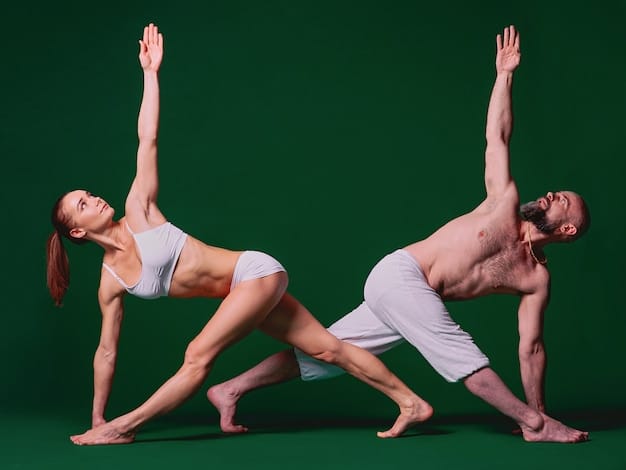Power Yoga vs. Hatha: Which Burns More Calories?

Power Yoga, a faster-paced, intense practice, tends to burn more calories than Hatha Yoga, which focuses on holding poses longer, though the exact difference varies depending on individual factors.
Struggling to choose between Power Yoga and Hatha for your fitness goals? The answer to which style burns 25% more calories isn’t as straightforward as you might think, but we’re here to break it down.
Understanding the Basics of Hatha Yoga
Hatha Yoga is often considered the foundation of many modern yoga styles. It emphasizes holding poses for a longer duration, focusing on breath control and alignment. Let’s delve deeper into what Hatha entails.
Hatha’s gentle approach might not seem like a calorie-torcher at first glance, but its benefits extend far beyond just burning calories. It’s about building a strong foundation for your yoga practice.
Key Elements of Hatha Yoga
Hatha Yoga incorporates several key elements that contribute to its unique approach to physical and mental well-being.
- Holding Poses (Asanas): Hatha Yoga focuses on holding each pose for several breaths, encouraging strength and stability.
- Breath Control (Pranayama): Conscious and controlled breathing is a vital component, helping to calm the mind and increase energy flow.
- Alignment: Paying close attention to proper alignment in each pose minimizes the risk of injury and maximizes the benefits.
- Mindfulness: Hatha encourages present moment awareness, connecting the body and mind through focused attention.
In essence, Hatha Yoga is about slowing down, being present, and connecting with your body, offering a more meditative approach to physical fitness.
In conclusion, Hatha Yoga provides a solid base for yoga practice, focusing on mindfulness and alignment over intense calorie burn. It is about building stability and awareness, making it accessible to all levels.
Exploring the Intensity of Power Yoga
Power Yoga is a dynamic and vigorous style of yoga that takes its roots from Ashtanga, but with more freedom in sequencing. This style emphasizes strength, flexibility, and endurance through a continuous flow of poses.
Power Yoga distinguishes itself with a faster pace and a greater emphasis on building heat within the body. This makes it a popular choice for those seeking a more physically demanding workout.

Distinctive Features of Power Yoga
Several distinctive features set Power Yoga apart from other forms of yoga.
- Continuous Flow (Vinyasa): Power Yoga strings poses together in a flowing sequence, often linked by vinyasas (a series of poses transitioning from plank to chaturanga through upward-facing dog to downward-facing dog).
- Emphasis on Strength: Many Power Yoga sequences incorporate poses that challenge your strength, such as planks, push-ups, and balancing postures.
- Faster Pace: Unlike Hatha, Power Yoga moves at a quicker tempo, elevating your heart rate and boosting calorie expenditure.
- Customization: Teachers have more freedom to vary the sequences, making each class unique and challenging.
The emphasis on continuous movement and strength-building exercises contributes to its higher calorie-burning potential.
In conclusion, Power Yoga is designed to push your physical limits and elevate your heart rate, combining strength, flexibility, and endurance into a single, intense workout.
Calorie Burn Comparison: Hatha vs. Power Yoga
When it comes to calorie burn, Power Yoga generally comes out on top. However, the actual number of calories burned in either style can vary significantly based on individual factors and the specifics of the class.
Let’s compare the typical calorie burn rates and explore the factors that influence these numbers.
Factors Influencing Calorie Burn
Several factors can influence the number of calories burned during a yoga session, regardless of whether it’s Hatha or Power Yoga.
- Intensity of the Class: A more challenging class with advanced poses and faster transitions will naturally burn more calories.
- Instructor Style: Some instructors push students harder than others, leading to a more intense workout.
- Individual Metabolism: Each person’s metabolic rate affects how quickly they burn calories.
- Body Weight: Heavier individuals typically burn more calories than lighter individuals during the same activity.
Therefore, while Power Yoga generally burns more calories, Hatha Yoga practiced vigorously can still offer a substantial workout.
In summary, Power Yoga tends to burn more calories due to its vigorous nature, but the actual number varies based on numerous factors related to the class and the individual.
The Science Behind Calorie Expenditure
Understanding the science of calorie expenditure helps clarify why Power Yoga typically burns more calories than Hatha. It is important to understand the physiological processes that occur during these practices.
The key is looking at what happens to your body when engaging in more intense activities.
How Intensity Affects Calorie Burn
The intensity of physical activity directly impacts calorie expenditure through several mechanisms.
- Increased Heart Rate: Vigorous activity elevates your heart rate, requiring more energy and burning more calories.
- Muscle Recruitment: Power Yoga involves more active muscle engagement, leading to greater calorie consumption.
- Oxygen Consumption: Intense workouts increase oxygen consumption, indicating a higher metabolic rate and calorie burn.
- Post-Exercise Oxygen Consumption (EPOC): After a strenuous workout like Power Yoga, your body continues to burn calories at an elevated rate to recover.
By understanding these elements, it transforms into easier to select the best style of yoga for the goals established.
In conclusion, the scientific principles of energy expenditure show that Power Yoga’s higher intensity leads to greater calorie consumption because of increased heart rate, muscle use, oxygen consumption, and EPOC.
Additional Health Benefits Beyond Calorie Burn
While calorie burn is a common focus, both Hatha and Power Yoga offer various health benefits that extend beyond weight management. These benefits can improve overall well-being.
Both styles have distinctive strengths that cater to different wellness goals.

Holistic Health Advantages of Yoga
Both Hatha and Power Yoga provide a variety of holistic health advantages, regardless of their calorie-burning levels.
- Improved Flexibility: Regular yoga practice enhances flexibility, making daily activities easier and reducing injury risk.
- Stress Reduction: Yoga promotes relaxation and mindfulness, helping to manage stress and improve mental well-being.
- Increased Strength: Both styles of yoga build strength, supporting better posture and physical function.
- Enhanced Balance: Yoga improves balance and coordination, which is essential for overall physical health.
Therefore, selecting a style that suits you is more about the benefits than the calorie burn.
In summary, beyond calorie burn, Hatha and Power Yoga each provides unique holistic health advantages, including flexibility, stress reduction, strength, and balance, making them both precious additions to well-rounded fitness regimens.
Making the Right Choice for Your Fitness Goals
Ultimately, the choice between Power Yoga and Hatha Yoga depends on your personal fitness goals and preferences. It’s about finding what resonates with you and suits your lifestyle.
Consider the following advice to steer your decision.
Tips for Choosing the Right Yoga Style
The ideal option between Power Yoga and Hatha Yoga must be based on personal taste and fitness objectives.
- Assess Your Fitness Level: If you’re new to yoga, Hatha may be a gentler introduction; more experienced practitioners may crave Power Yoga’s intensity.
- Consider Your Goals: If weight loss and calorie burn are your priorities, Power Yoga might be the better choice; if relaxation and flexibility are more important, Hatha is ideal.
- Listen to Your Body: Pay attention to how each style makes you feel; choose the one that leaves you feeling both challenged and refreshed.
- Try a Variety of Classes: Experiment with different instructors and classes to find a style and teacher that resonate with you.
By integrating yoga with these tips, you can start benefiting from its effects.
In conclusion, deciding between Power and Hatha Yoga depends on your fitness level, goals, and personal preferences, with the best option being one that challenges and recharges you.
| Key Point | Brief Description |
|---|---|
| 🔥 Calorie Burn | Power Yoga generally burns more calories due to its intensity. |
| 🧘 Flexibility | Both Power and Hatha Yoga improve flexibility with consistent practice. |
| 💪 Strength | Power Yoga builds more strength due to its dynamic poses. |
| 😌 Stress Reduction | Both styles significantly reduce stress through mindfulness and breathing. |
Frequently Asked Questions
▼
Not necessarily. Power Yoga generally burns more calories, but consistency and enjoying your workout are key. Hatha Yoga can also contribute to weight loss through increased mindfulness and reduced stress.
▼
It depends on your fitness level and how your body responds. It’s crucial to listen to your body and incorporate rest days to prevent overtraining and injury. Balancing with gentler practices is also advisable.
▼
Yes, Hatha Yoga is often recommended for beginners due to its slower pace and emphasis on foundational poses. It allows you to build strength, flexibility, and body awareness gradually and safely.
▼
Generally, you only need a yoga mat. Blocks, straps, and blankets can be helpful for modifications and support, especially in Hatha Yoga. Comfortable clothing that allows for a full range of motion is also important.
▼
Practicing yoga 2-3 times a week can lead to noticeable improvements in flexibility, strength, and stress levels. Consistency is key, but even short, regular sessions can provide significant benefits. Listen to your body.
Conclusion
In the debate of Power Yoga vs. Hatha, the “winner” depends entirely on your personal needs and preferences. While Power Yoga may offer a higher calorie burn, both styles provide a wealth of physical and mental benefits, so choosing the one that best fits your goals and makes you feel good is the most important factor!





